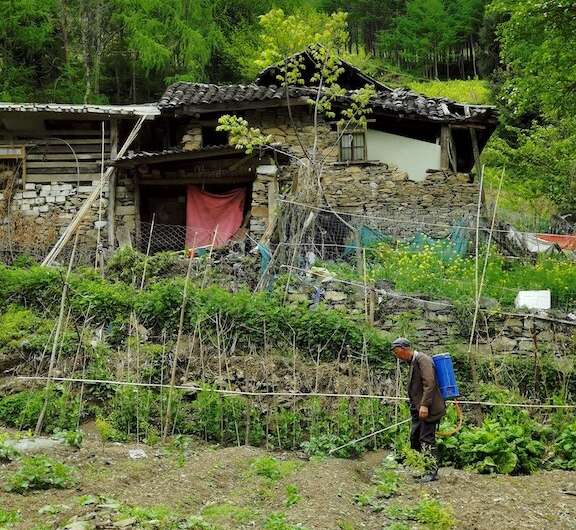A farmer in the renowned Wolong Nature Reserve in southwestern China joins about 5,000 people who are neighbors with the protected giant pandas. Scientists are creating ways to understand how peoples' daily actions can help or hurt sustainability efforts. Credit: Hongbo Yang, Michigan State University
Today's anxiety-ridden world is full of sweeping governmental policies meant to ease human suffering and protect the environment. A new study speaks to the value of the holistic look at people's everyday lives to reveal unexpected potholes in the best-laid policy paths.
Such as, how a rural worker's unhappiness when leaving for cities to provide for their families can unexpectedly offset the benefits to their finances and the health of the forests back home.
"Even as we race to find ways to make the world more sustainable and just we must pay attention to the details in how people relate to their environment," said Jianguo "Jack" Liu, Michigan State University's (MSU) Rachel Carson Chair in Sustainability. "Until we assure that both people and the natural world can thrive, we will suffer setbacks to a more sustainable world."
Liu and Hongbo Yang, lead author and former Ph.D. student at MSU's Center for Systems Integration and Sustainability, now a researcher at the Research Center for Eco-environmental Sciences, Chinese Academy of Science, join other authors in exploring the human element that adds layers of complexity to the United Nation's effort to achieve 17 Sustainable Development Goals (SDGs) by 2030.
In this week's Ecology and Society Liu, Yang and their colleagues developed a novel way to understand how human activities—and uniquely human consequences—can cause unintended consequences.
The goal: Striving to understand how efforts to promote some of SDGs might disrupt progress in others. The paper looked at the impacts of four globally common livelihoods—raising crops, local non-farm work, workers who temporarily migrate to jobs in cities and send money home, and livestock husbandry—on the interrelationships among SDG 1 (no poverty), SDG 3 (enhance human well-being), and SDG 15 (protect life on land).
As the paper notes, the grand challenges facing humanity, from poverty, water scarcity, and food insecurity to climate change and biodiversity loss are closely intertwined. This work focuses on understanding what people bring to the complicated equation and uses China's Wolong Nature Reserve as a demonstration site. That's home to many of the world's beloved giant pandas, as well as some 5,000 people.
"This is challenging because efforts made to promote one goal often result in unintended impacts on the others, resulting in puzzling interrelationships among the goals that beg for explanations," Yang said. "What our approach provides is a tool to support coherent decision making that can facilitate progress towards SDGs simultaneously."
The work deployed the metacoupling framework, a relatively new conceptual tool that help researchers to build comprehensive models to understand socioeconomic and environmental interactions both in specific places and over distances. Born in MSU's Center for Systems Integration and Sustainability, the metacoupling framework provides a new language to look at the big picture and at the detail simultaneously.
Using that method to understand human-nature interactions in many levels allowed the group to reveal unexpected insight. For instance, workers from Wolong who set out to temporary jobs in cities make more money, which can help offset the amount of fuelwood they remove from the forests—a big problem for the fragile panda habitat. So that's wins for SDG 1 and SDG 15 (income and wildlife habitat). But what was less obvious was that many workers weren't happy. Being homesick and obstacles to their children's educational opportunities in cities were among the problems. So, benefiting habitat via labor migration was coming at the expense of SDG3 (human well-being).
And that signals long-term liability of what at first seemed like a slam dunk benefit.
This level of holistic scrutiny, the authors contend, will allow policymakers a real-life view from which they make adjustments to reduce conflicts, and that the methods will open the door to more understanding of the SDGs challenges.
More information: Hongbo Yang et al, Unraveling human drivers behind complex interrelationships among sustainable development goals: a demonstration in a flagship protected area, Ecology and Society (2022). DOI: 10.5751/ES-13275-270315
Journal information: Ecology and Society
Provided by Michigan State University
























